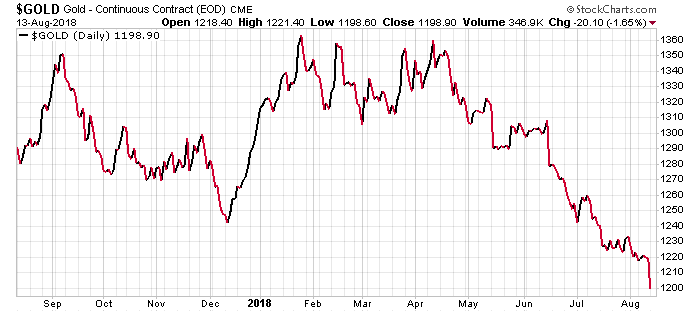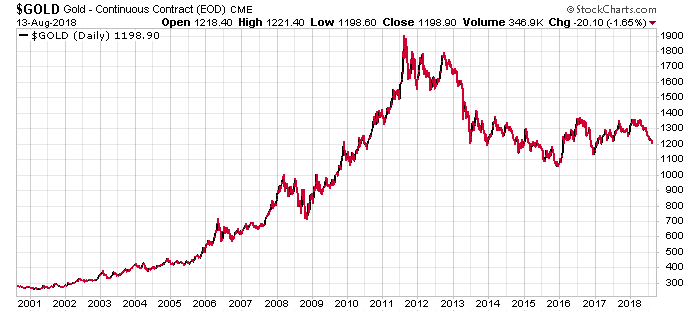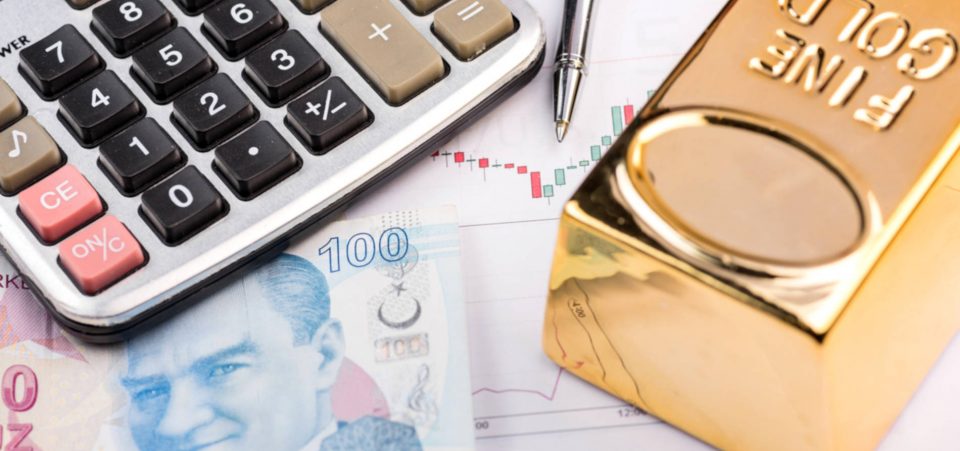In Times of Crisis, the Gold Price Moves Higher—This Is Why It Hasn’t…Just Yet
The gold price has not wavered from its downward course.
On August 13, the gold price fell below the $1,200-per-ounce price floor to stop just above $1,197 per ounce.

Chart courtesy of StockCharts.com
For over a year, as the chart above shows, the gold price had managed to stay afloat, averting a psychological drop.
Why Has the Gold Price Fallen so Sharply?
The explanation is that many investors are not thinking creatively. Rather, they all seem to be reacting in textbook ways. In other words, the main reason that the demand for gold has dampened has to do with the U.S. dollar.
The higher the dollar goes, the less appeal gold has. That’s what investors are thinking when it comes to the gold price.
And the dollar’s strength was on full display over the weekend. Instead of gold moving higher, as precious metals often did during episodes of international or national uncertainty, the dollar has risen in value instead.
In more predictable times, a financial crisis such as the recent one affecting Turkey—especially one with significant geopolitical repercussions—would have pushed the gold price higher.
But now it’s all about the U.S. dollar in the short term.
With gold having gained significant value over the past few months, Turkey’s troubles with its currency—the Turkish lira—have offset the safe-haven effect that crises usually create for gold.
As the theory goes, because gold is traded in dollars, investors suddenly discover—as if they didn’t know before—that it becomes too expensive. That then curbs demand for the precious metal.
In the context of the Turkish lira crisis, prospects suggest the dollar will continue to increase, further curbing the attraction of gold (under that logic). Therefore, many experts and financial managers will advise their clients to follow the herd, staying away from gold.
Gold Is Rare and Demand Will Always Be High
It’s an odd argument. After all, in the context of luxury goods, say cars—and it’s not unfair to compare gold to a “Rolls Royce,” “Bugatti,” or “Ferrari”—the prices of their top models are often higher than listed. Making them cheaper while maintaining the same supply would only push the price back up.
Ask anyone who has bought a house in New York City or San Francisco lately what happens when the list price seems “reasonable” or affordable. A bidding war ensues.
And gold is a limited resource. Even in the universe, it’s one of the rarest elements. (Source: “Why is gold rare?,” Science Focus, October 4, 2012.)
Of course, the Turkish lira is just the latest excuse to speed up the gold price’s demise.
Experts and investors have been repeating the mantra that “the dollar is going higher because of rising interest rates.”
This has generated a cloud of pessimism since February, when Federal Reserve Jerome Powell replaced the outgoing Janet Yellen, confirming the interest rate hikes.
The gold price was moving in a favorable direction in January. One reason was that Trump hinted that he did not like higher rates. Thus, investors thought that his appointee, Powell, was picked because of like-minded opinions on the matter.
But the Fed is an independent institution. It’s not even an official institution of the government— at best, it is a private/public entity. But it is entirely politically independent. (Source: “Here’s Who Actually Owns The Federal Reserve,” Business Insider, October 26, 2013.)
Nevertheless, everyone thinks interest rates will keep going higher, raising the value of the dollar, forcing gold prices to drop. This has prompted, of course, speculators to go short on gold. The dropping trend, which has intensified since July, will accelerate now, given that short positions will probably increase.
But is that a valid argument?
The Turkish Crisis Is a Lot Like the Argentinean Crisis of 2000
There is clear historical evidence that the speculators will have to cover their tracks—and soon. They are wrong. The Turkish crisis—or the Turkish lira crisis, more precisely—should have encouraged more sales of gold.
The first reason why is that gold often reacts with a little delay to stressful events, as was the case with the Argentinean crisis in the early 2000s.
This is not to say the causes are the same. The Argentinean “depression” (1998–2002) was triggered by the fact that its currency, the peso, had been pegged to the dollar in the booming 1990s. The Turkish lira has been increasingly backed by gold bullion.
But it doesn’t matter because the effects on gold may well be similar.
Indeed, Turkey has been an avid buyer of gold. That habit has intensified under President Recep Tayyip Erdoğan, who has encouraged the Turkish Central Bank to buy even more gold lately. After Russia, Turkey has become the second-largest buyer of gold in the world.
Turkey Plays a Crucial Role in the World Market for Gold
Given the political implications of the crisis—which could end up pushing Ankara away from the North Atlantic Treaty Organization (NATO) and directly into the arms of Moscow and Beijing—Erdoğan will sooner sell his reserves of foreign currency than his gold.
The pressure will end up on the dollar and the euro, and short-sellers will have to start taking cover, triggering a gold price rebound.
In addition, tensions always end up favoring gold—even if it takes a while for investors to notice.
The Turkish lira’s devaluation crisis has put pressure on several emerging market currencies. They will all drop due to higher U.S. interest rates. In fact, higher interest rates could cause a global economic crisis.
If that isn’t a scenario for prompting more gold demand, consider the international turmoil that losing a strategic country like Turkey would create for Europe, NATO, and the United States.
Turkey Should Have Caused—and Eventually Will Cause—Gold Demand to Spike
But, as it did during the Argentinean crisis—and this is where the similarity with Turkey lies—gold tends to backfire or have a delayed reaction to stressful international events.
Now, charts or previous performance do not predict something as fickle as speculation. But gold is a rather old and “conservative” resource, which thrives on the effects of a crisis.

Chart courtesy of StockCharts.com
Notice the gold price chart above. It starts in 2000 around the time the Argentinean peso crisis would reach its peak.
Yet, the gold price does not move until 2003. Then it starts curving upward, steadily increasing until the peaks of 2011.
If anything, the current drop in the gold price, then, presents a great opportunity—if history is an indicator.
Moreover, it should be noted that Argentina, while a large and resourceful country, does not play the delicate geopolitical role of Turkey. Therefore, expect even greater repercussions on the gold price, which should get all its safe-haven investment “mojo” back in the next few years.
The old saying “silence is golden” may be overrated in its effectiveness. The better saying might be “patience is golden.”






